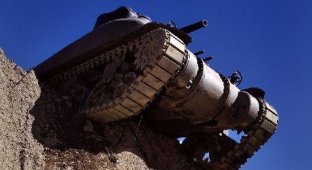Antiques and artifacts of World War II (10 photos + text)
Antiques from the Second World War are always very valuable to collectors. Among such antiques you can always find awards, weapons, or simply personal belongings of soldiers who took part in battles. I bring to your attention a large selection of the most expensive things that were sold at auctions and are directly related to the events of 1939-1945.
Hawker Hurricane fighter

Cost: $2.1 million - $2.6 million
Large military equipment is an infrequent guest at auctions: firstly, the bulk of tanks and aircraft that have survived to this day are at the disposal of museums; secondly, potential buyers are deterred by the difficulties associated with transporting and storing the purchased lot. Be that as it may, Bonhams expects to sell a 1942 British Hawker Hurricane single-seat fighter for more than $2 million. Equipped with 12 machine guns, the aircraft belonged to the Royal Canadian Air Force and was apparently patrolling the East Coast, where enemy submarine activity was observed. The Hawker Hurricane is now fully operational and comes with a flight permit as a bonus.
Edward Kenna's Battle Honors

Cost: $990,000
In 2011, a set of medals and orders of Private Edward Kenna, an Australian by birth, went under the hammer. The buyer remained incognito, but it was obvious to everyone who followed the auction that he was primarily seeking to take possession of the Victoria Cross - the most prestigious military award in Great Britain, which is awarded for outstanding heroism shown on the battlefield. The Victoria Cross is extremely rare at auctions: it is usually either kept as a family heirloom or transferred to a museum. However, the descendants of Edward Kenna disposed of the inheritance differently. Kenna received his Victoria Cross for the fact that in May 1945 in Papua New Guinea, under heavy fire, he single-handedly attacked an enemy bunker and destroyed a crew of Japanese machine gunners.
Hitler's writing instrument

Cost: $423,000
No matter how repulsive Hitler's personality may be, there are many who want to purchase items that belonged to him. The Fuhrer's writing instrument, put up for sale by the Alexander Autographs auction house, aroused great interest among collectors. It consisted of a massive bronze stand decorated with the coat of arms of the Third Reich, two inkwells and a paperweight. The artifact was removed from Hitler's residence by US Army Lieutenant Jack McCon at the end of the war. Many years later, the man saw on television documentary footage of the signing of the 1938 Munich Agreement on the division of Czechoslovakia. In the recording, McCon saw his war trophy. Only then did the veteran realize that he had a very expensive item in his hands.
Letters of Anne Frank

Cost: $328,000 ($165,000 excluding inflation)
Although the number of victims of the Hitler regime is in the millions, the figure of Anne Frank has traditionally served as a symbol of their suffering: the fate of an individual child embodied the tragedy of all humanity. Today it seems blasphemous even the idea that objects associated with a girl’s personality could be involved in commodity-money relations. However, in 1988, two letters and a postcard sent by the Frank sisters to their American girlfriends during the war were put up for sale. There was a serious stir: actress Whoopi Goldberg, among others, took part in the auction - although she never became the owner of the treasured letters. The person who purchased them wished to remain anonymous; He donated a valuable lot to the Simon Wiesenthal Center.
Enigma encryption machine

Cost: $208,137 (?133,250)
The first examples of the Enigma encryption machine went on sale in the 1920s, but this device began to be widely used for military purposes already during the Second World War. Most of the Enigmas released by that time were at the disposal of the Third Reich. Although the odds of breaking the code were more than 150,000,000,000,000,000,000 to one, British codebreakers still found a way into this bastion of secrecy. After the fall of the Hitler regime, soldiers of the victorious armies began to export Enigmas from Germany en masse, and now acquiring a rare encryption machine will not be difficult. The one that was sold at Christie’s in 2011 was given weight by the fact that it participated in the filming of the film “Enigma,” for which Tom Stoppard wrote the script.
Robert Dennis Gay Award Set

Cost: $71,289 (?45,000)
The name of the British Army Sergeant Major Robert Dennis Gay is known only in narrow circles, although his feat certainly deserves to go down in history. In September 1944, Gay, as part of the Dutch operation, ended up in Arnhem, where fierce fighting soon began between the Allied troops and the Nazis. During the next attack, the road to the 156th battalion of the 4th parachute regiment was blocked by an enemy tank. Without hesitation for a second, Gay rushed across him to take the fire and save his comrades. He miraculously survived, although he was seriously wounded in the leg. Gay subsequently ended up in a prisoner of war camp, where he cared for shell-shocked soldiers. In 2011, at a Sotheby’s auction, the awards he earned were bought by a private collector.
American Airborne Helmet

Cost: $68,621 (€46,000)
The greatest demand at auctions is often for items associated with specific historical figures: collectors are willing to pay much more for Churchill’s snuff box or Hitler’s paperweight than for the uniform of an unknown soldier. However, there are exceptions to any rule: in 2009, the helmet of an American airborne paratrooper, whose identity was not established, went under the hammer. Based on the markings, we learned that he belonged to the 502nd Parachute Infantry Regiment of the 101st Airborne Division. This unit of US troops is known for its participation in the Normandy operation. There, in Normandy, in the city of Sainte-Mère-Eglise in the 1960s, a helmet was found. Bidding for it began at a modest €3,500, which was eventually exceeded 13 times.
Peter White Archive

Cost: $59,790 (?30,000)
Eyewitness diaries are a huge help in studying the Second World War for historians. They are also prized by collectors: in June 2007, at Christie’s auction, the Peter White Archive, which included several thick notebooks in which the young American infantryman meticulously described his misadventures from January 1938 to August 1944, was sold for almost $60,000. White was not only a brave fighter, but also a talented artist: he accompanied his observations with illustrations. More than 730 sketches made in ink, pencil, and sometimes even paint are considered the most important part of the archive. The lieutenant tried to sketch literally everything that surrounded him: from the design of enemy aircraft to the details of a soldier’s life in the trenches.
Letter from Dwight Eisenhower

Cost: $38,837.50
Dwight Eisenhower became one of the key figures in the American command in World War II. At first, he made strategic decisions at army headquarters, and then went to the front, where, as supreme commander in chief, he led the actions of the allied forces in North Africa, the Mediterranean, and Normandy. The authority of the future president was enormous. It is not surprising that a high price was set for the letter he sent on June 13, 1945 to US Air Force General Hoyt Vanderberg. It does not contain any secret information: Eisenhower pays tribute in lush terms to the achievements of the American army and shares his joy that Europe has finally freed itself from the Hitlerite yoke, which completely “contradicted democratic ideals.”
Douglas Bader's logbook

Cost: $37,300 (?23,500)
If Russian children are brought up on stories about the feat of Alexei Maresyev, then for the British the name of Douglas Bader is synonymous with the concept of “heroism”. An RAF pilot was involved in an accident in the early 1930s and lost both legs. After passing a series of medical checks, Bader was reinstated in service and took part in World War II along with healthy pilots. He shot down more than two dozen German aircraft and played an important role in the outcome of the Dunkirk operation. Even after being captured by the enemy, Bader did not lose courage and after several years of imprisonment returned home alive. Any item that this outstanding military figure held in his hands evokes awe among the British and is highly valued by collectors.






















